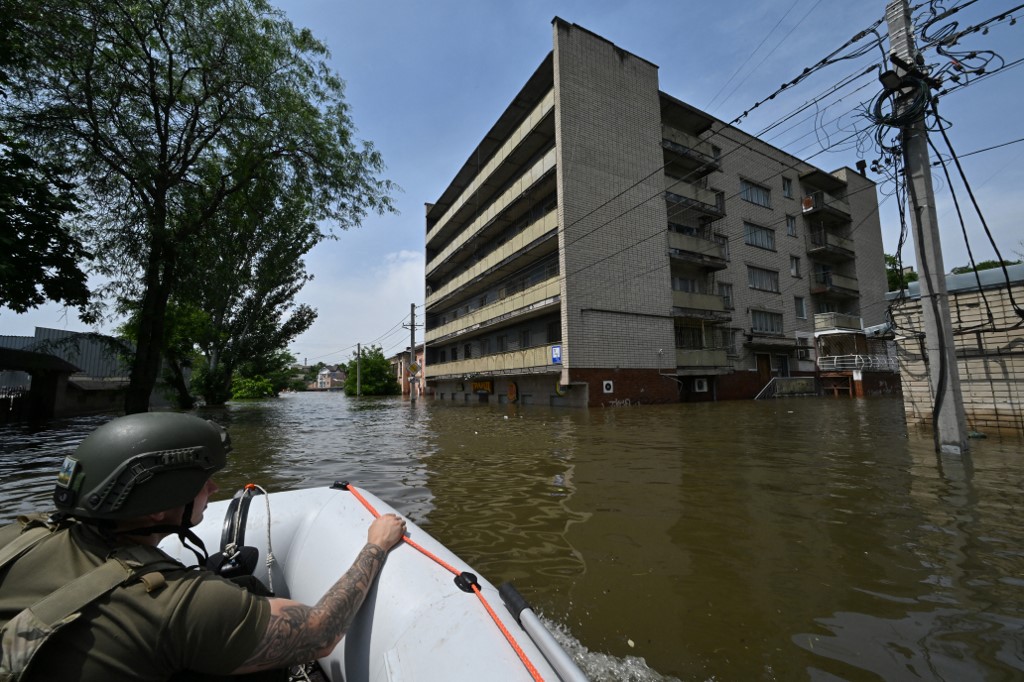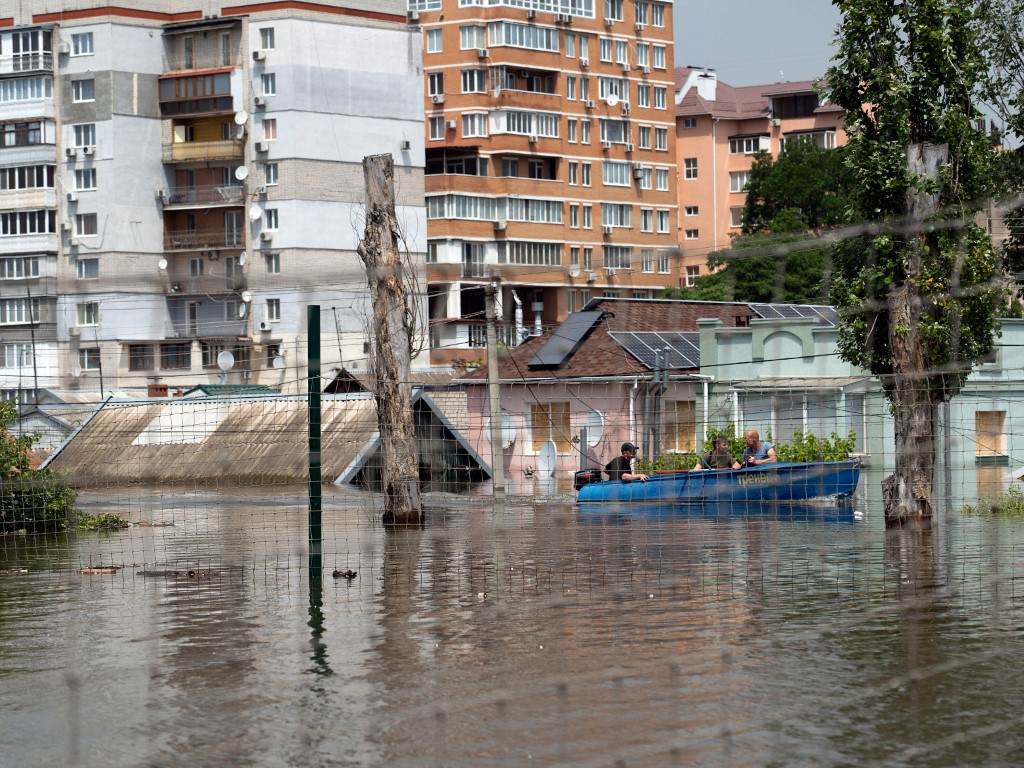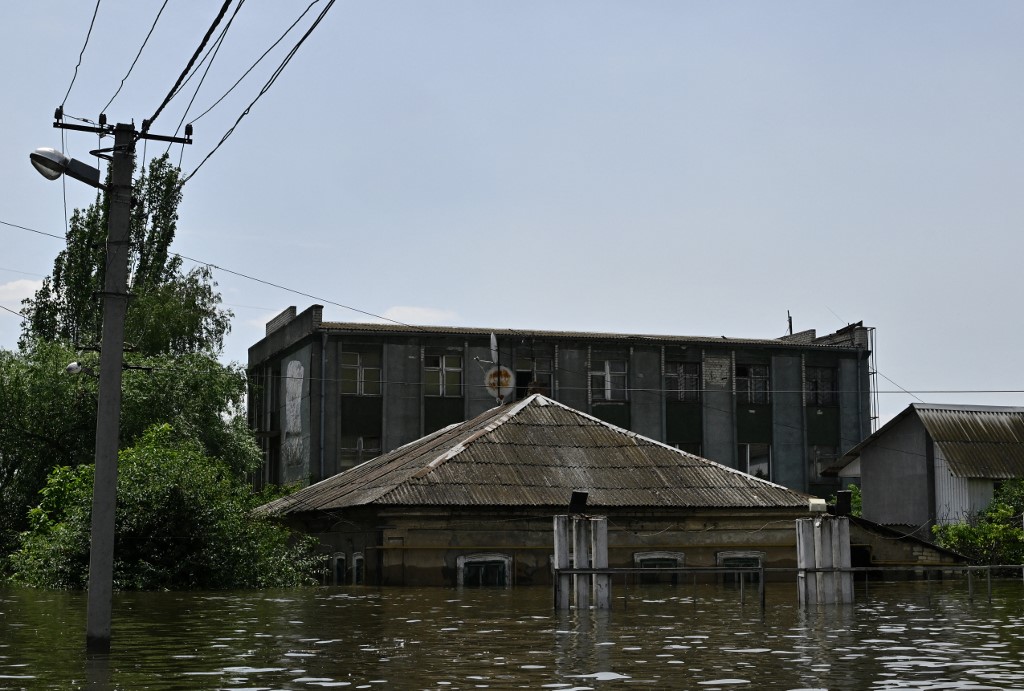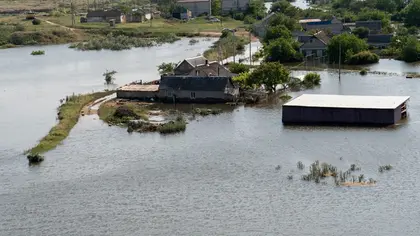The Russian government has rejected a UN request for access to the occupied territories of the flooded Kherson region. Reuters has published images of drowned people from the town of Hola Prystan.
The Russian-appointed head of the region, Vladimir Saldo, reported about 25 dead and 17 missing during his visit to an economic forum in St Petersburg. But the real situation after the destruction of the Kakhovka dam in the Russian-occupied territories of the Kherson region is still unknown.
JOIN US ON TELEGRAM
Follow our coverage of the war on the @Kyivpost_official.
Kyiv Post spoke to 51-year-old Kherson resident, Alina (names have been changed at the request of those interviewed), whose parents lived in Hola Prystan during the flooding.

A serviceman of the National Guard of Ukraine sails on boat during a food delivery to the residents of a flooded area in Kherson on June 8, 2023, following damages sustained at Kakhovka hydroelectric power plant dam. Genya SAVILOV / AFP
Stuck on the other side of the river
At the home Alina’s parents – 82-year-old Andrey, who is blind, and 70-year-old Tatyana – the Dnipro’s waters started coming in on June 7, the day after the Kakhovka dam collapsed. Feeling the water under his feet, Andrey groped up the wooden stairs to the attic of the two-story house. His wife Tatiana had trouble getting up the stairs. All Andrey could remember was that his wife, at some point, said she couldn’t go on anymore.
“The last time I spoke to my mother was June 6 at 16:12,” Alina recalls in a conversation with Kyiv Post.

South Korea Demands 'Immediate Withdrawal' of North Korean Troops in Russia
On June 6, the day after the dam broke, Alina reassured her parents that the water would not reach them. But toward nightfall, the current became very strong, and the water started to rise very quickly.
One of the main problems of the occupied territories is the lack of any internet or mobile connection with Ukraine. On the upper floors of some houses, it’s at times possible to catch a connection from a Ukrainian mobile operator from the right (north) bank of the Dnipro. Otherwise, some communication can only be maintained through internet messengers. Direct calls to Russian numbers – which the residents of the left bank of the Kherson region have been forced to use since last summer, when the Russians destroyed all Ukrainian mobile communications on the occupied territories – are impossible from Ukraine. Whereas calling via Skype or Viber requires money, and it’s not always stable. So no one could have warned of the real threat.
The Russian-appointed Saldo became famous on June 6 with a video in which, with a flooded city in the background, he reassures residents of Nova Kakhovka – the closest town to the destroyed hydroelectric plant – and other towns on the left bank that everything is fine and life continues to go on as usual.

Local residents travel on a boat through floodwaters in Kherson on June 8, 2023, as water levels rose in the city following damage sustained at Kakhovka hydroelectric power plant dam. Oleksii FILIPPOV / AFP
Virtual dragnet and Russian occupiers in denial
“It’s hard to ask people who live in Hola Prystan what’s going on there,” Alina explains to Kyiv Post. “Communication is poor, no electricity, and phones run out quickly. Ukrainian numbers work along the banks, but Russian numbers don’t. Deeper into town – vice versa.”
On June 8 Alina submitted data about her parents to the Ukrainian State Service for Emergency Situations in Kherson. She also posted the information in all online groups and chat rooms.”
Lists with hundreds of names and photos wandered from one messenger to another. There was almost no way to update who was eventually found and who was not.
A Kyiv Post reporter found information about Alina’s father in the Instagram account of a woman from Moscow, who had left Russia at the beginning of the war and has since moved from country to country, eventually settling in Armenia, where she is now. She coordinates and informally supports various volunteer foundations, organizations and private initiatives.
Kyiv Post also tried to contact any such organizations or people directly for comment. But one Russian woman who helped with information about missing people in Oleshky and Hola Prystan refused to comment because she “had returned to Russia and had already been visited [by police or FSB].”
Another Russian woman said she did not have complete information because she was just the coordinator.
In general, from the many messages in online groups and chat rooms dedicated to the evacuation and rescue of people on the Russian-occupied bank of the Kherson region, the impression is that the Russian authorities were saving themselves and their military in chaos for the first two days. Only when they realized the scale of the catastrophe did they cut off access for local volunteers, limiting invitations to controlled propagandists and politicians.
They continued, however, to conceal the actual extent of the flooding. According to Alina, the Russian Ministry of Emergency Situations only got involved in the evacuation when the water stopped flowing – a few days after the dam broke.
Appearing on Instagram
“My dad became an Instagram star,” Alina reported on June 14, eight days after the dam collapsed. “Crimean volunteers were taking pictures of him. He had blue legs, and trembling lips.”
A video of Alina’s father appeared on the Instagram account of a Crimean woman who regularly brings volunteer aid to the Russian military in the Kherson region. In the video, an older man with cataracts in his eyes, naked and covered by old clothes, shivering from the cold, recounts how he climbed from the water to the attic, how his wife did not make it, how the stream then carried him along either on planks or on foam board, and how he left his pension, documents and a cat in the attic. The video was posted on June 14 but most likely recorded a few days earlier.
On the evening of June 9, Viktoria, a resident from one of the seaside villages in the Kherson region, recorded a voice message, which reached Alina through several people a few days later.

Houses are flooded in the town of Kherson on June 8, 2023, following damages sustained at Kakhovka hydroelectric power plant dam. Genya SAVILOV / AFP
A woman says she took food to Hola Prystan to help the victims and picked up an undocumented old man there. She brought him to Skadovsk (55 kilometers from Hola Prystan). A man gave his name and address. It was Alina’s blind father. He asked to look for a woman – his wife. He had sat without food for three days and drunk dirty water. Then he was fed and taken to the hospital for examination.
“I don’t know what more to tell you. That’s all I can say,” the woman’s trembling voice on the recording says. “But when the water was rising, he climbed up the steps, and his wife wanted to climb up there, but her legs were hurting and a step broke – he was trying to get her out, but she was sitting down. He spoke to her, she said goodbye and said, ‘That’s it, I can’t take it anymore.’”
Viktoria's last words are the most painful, and she utters them through tears. “He said she’d drowned. I don’t know if it’s true, but those were his words.”
Thanks to this woman, who drove Alina’s father from Skadovsk to another hospital Alina was able to reach him via Telegram and talk.
“Dad said on the first day, someone was driving around shouting about evacuation. But everything sounded the same as before [from October 2022]. No one said everything was deadly dangerous, and people had to evacuate. And the military even took boats away from locals when they tried to search for relatives,” Alina said.
“Now my father is in the hospital because he has nowhere else to go, but I’m more relaxed about him – a volunteer girl will bring home-cooked food to the village hospital. Still, everyone advises me to find someone to take him through Crimea to Europe – he has severe illnesses apart from being blind. He had new slippers brought to the hospital. He was pleased with them and said they were very soft.”
On June 16, Alina received another message from Hola Prystan. A drowned person had been found in her parents’ house. The body was taken to Kalanchak (50 kilometers from Hola Prystan). A representative from the Russian ambulance said they didn’t have such a person (Alina’s mother) by name, but there are unidentified bodies. Alina needs to come [to the occupied territory] and identify her mother. They need DNA samples from a blood relative. Neither of these is possible now – the Dnipro River is literally the front line, and there are no physical crossings.
On June 17, Alina received one more message from a friend in Hola Prystan: “I called the local emergency ministry. There’s no list of the dead yet. They probably have too many and do not want to make it public. Officially there are only 18 people drowned. But this is a lie, of course.”
Alina submitted an online application to the Red Cross to search for her missing mother.
On June19, the Ukrainian Defense Ministry’s National Resistance Center reported that according to preliminary figures, more than 500 people had died in the occupied Oleshky, which is about 10 kilometers closer to the dam than Hola Prystan.
You can also highlight the text and press Ctrl + Enter






